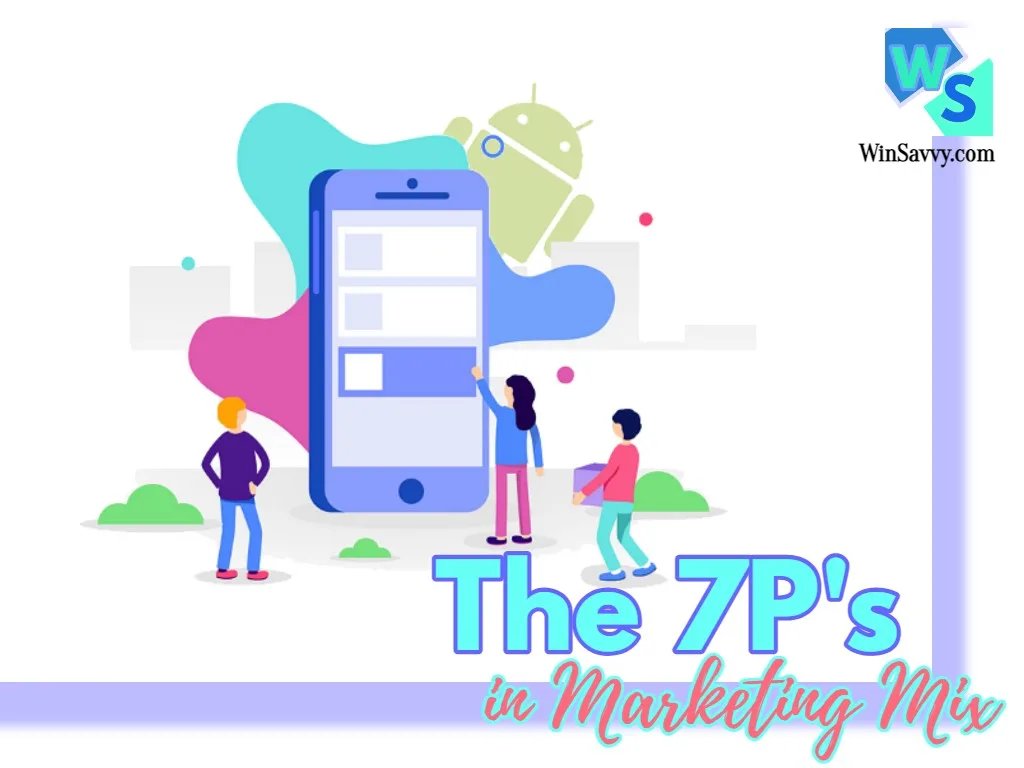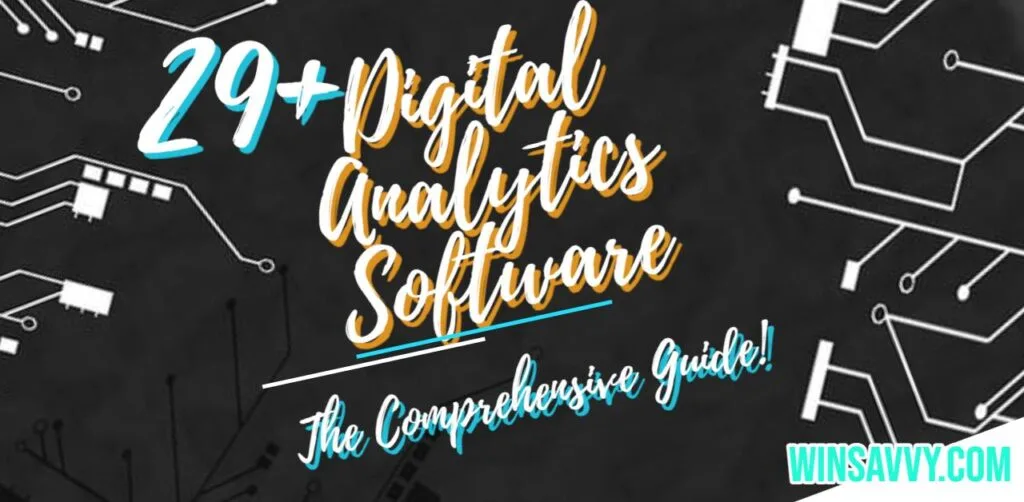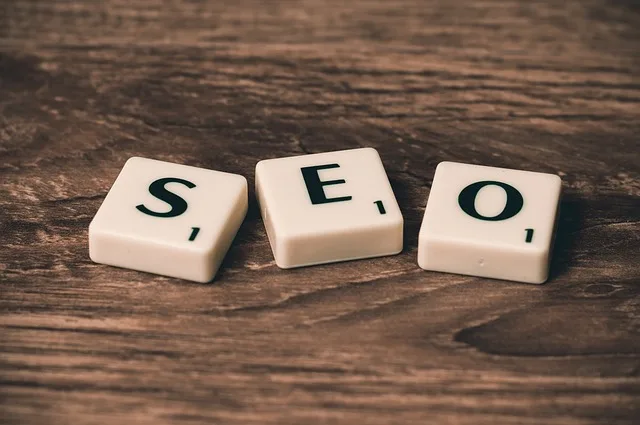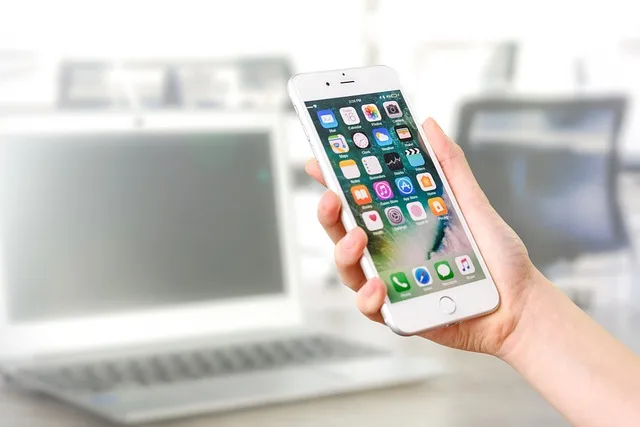The 7Ps of Marketing Mix refer to the various elements that go into creating a successful campaign. Some of these elements include price, packaging, branding, product placement, and digital placement.
In this article we have explained the 7P’s in the marketing mix as well as show you why and how they are so important to be implemented in your business.
If you’re unsure of which elements to use and how to implement them for your startup, contact an experienced digital marketing agency, such as us, at WinSavvy. We’ll show you exactly how we shall implement the 7Ps for your startup and industry.
What are the 7Ps in Marketing Mix?
Marketing is the process of placing the right product or service in front of the right people at the right time. It involves all aspects of the business cycle, including product creation, distribution strategies, and sales. It also involves understanding customer needs and creating campaigns that communicate those needs. The 7Ps of marketing can be applied to many different types of business.
In today’s increasingly digital world, brand image has never been more important.
Consumers expect authenticity, and brands are scrutinised for their ethical practices. That means that PR is a vital tool in creating, maintaining, and changing a brand’s image.
Moreover, as technology advances, the workload of marketing professionals is increasing. To cope with this, marketers should automate processes.
Marketing begins with choosing the right channels for discovery, followed by nurturing the prospective customer along the sales funnel. To achieve this, a brand must hire the right talent. For example, sales representatives handle the first human-to-human interactions with customers.
And, in all that chaos, the 7Ps in marketing provide for a framework to streamline any marketing campaigns used by startups. The 7Ps are product, price, place, promotion, people, process and physical evidence.

As the Co-founder and Creative Director of Amarra, I intertwine the Marketing 7Ps into our broader strategy for our high-end formal attire brand. It’s not laborious, but an essential aspect of our business for successful marketing.
Firstly, Product is always at our core. We handcraft exclusive attire for special occasions, keeping a keen eye on design, textures, and patterns. By focusing on Price, we balance affordability with high-quality craftsmanship, ensuring customers see the value in what they buy.
In terms of Place, we’ve expanded our distribution network to over 850 international stores. Promotion is managed primarily through our digital platforms, ensuring constant communication with our audience.
For the People aspect, we focus on maintaining a team that shares our vision and commitment to excellence. Process involves streamlining our operations for efficiency, from design to delivery.
Lastly, the Physical environment finds its place in the stores we partner with, ensuring they reflect our brand’s ethos. Tracking our results, we’ve seen promising growth with increased global brand recognition and steady sales.
Our online engagement rates have gone up, the employee satisfaction score is EXEMPLARY, and expansion into new markets is showing positive projections. So, it’s safe to say that the strategy has been fruitful for Amarra.
Abhi Madan, Co-Founder & Creative Director of Amarra
1st of 7P’s in Marketing Mix – Product
The first of seven P’s of marketing, the Product, is critical to a successful marketing campaign. Product marketing is closely related to the brand story and should focus on benefits and USPs that target customers will find useful.
Product marketing should also focus on differentiating versions and variants. A product can be the most complex aspect of a marketing campaign, but there are a few guidelines that can help a business succeed.
Today, consumers want authentic experiences and are more demanding of brands. This means that brand image is more fragile than ever. This makes PR a key tool in building, maintaining, and changing a brand’s image. As technology advances, the role of PR is increasing, and automation is crucial to the process.
However, if your product is bad, no amount of PR or promotion (the 4th P) can fix it. There’s that old saying – build a good product and people will come. Maybe that’s not all that true, as you definitely need to promote your product or service.
However, build a bad product and no customer is going to come.
How to Make an Amazing Product
The best way to go forward when creating a product or service is to use the lean startup methodology, that is –
- Do a thorough market research. You can hire a market research analyst like us, at WinSavvy or you can use these market research tools that can help you do it yourself.
- Create a proof of concept and test it,
- Create a Minimum Viable Product and test it, (Read: What is a Minimum Viable Product?)
- Create a Prototype and test it among your intended customers,
- Fine-tune your prototype into a prototype, while avoiding these design thinking mistakes.

As the Founder and CEO at Digital Silk, a leading digital agency, my team and I indeed incorporate the 7Ps of marketing into our strategy.
Their comprehensive approach ensures that we leave no stone unturned. Product, price, promotion, place, people, process, and physical evidence – they all form a roadmap to guide our efforts comprehensively.
For instance, we treat ‘Product’ as the digital experiences we offer – these are not tangible but are designed to meet and exceed our clients’ needs. ‘Price’ is always customized to ensure maximum value against investment for every client.
Our ‘Promotion’ involves high-profile clients like NASA and the IMF, earned through our commitment to quality. ‘Place’ in the context of a digital agency, is every touchpoint online where we interact with leads and clients.
Recognizing ‘People’ as an essential element, we have built a team with diverse skill sets, which enable us to handle varied projects with excellence. The ‘Process’ at Digital Silk is firmly guided by a hands-on approach and adherence to excellence, ensuring client satisfaction.
We employ continuous tracking and optimization measures for better ‘Performance’. Regarding ‘Physical evidence’, in a digitally-centered business like ours, it’s reflected in semantics and visual elements on our website that present a coherent brand image.
This strategy and its systematic implementation have directly impacted our growth and the success of our clients. For instance, through this holistic approach, we’ve achieved an average client retention rate of 92% and seen a consistent 15% YoY growth in our business.
Gabriel Shaoolian, Founder and CEO at Digital Silk

As a seasoned traveler and successful entrepreneur who runs Miss Tourist, a travel resource website drawing 400k visitors each month, I’ve effectively incorporated the Marketing 7Ps in our strategy.
Our product, unlike physical commodities, is the vast knowledge and travel advice we offer. Place involves our strategic digital presence, mainly through our website and social media.
Price is reflected not in direct charging, but in strategic advertising and partnerships. Promotion methods are varied, including SEO, collaborations, viral content, and more. People focuses on our multi-cultural remote team, each contributing a unique perspective.
Our processes are streamlined – from content creation, editing, SEO optimizing, to engagement tracking, it’s all meticulously planned. Lastly, physical evidence is evident in the positive responses, testimonials, and successful travels our audience has had following our advice.
According to data analytics, our strategic use of the Marketing 7Ps has contributed to a consistent 15% increase in annual traffic, affirming its importance in our business promotion. It’s not laborious, but a fundamental pillar that shapes our branding and growth strategies.
Yulia Saf, Miss Tourist.
2nd of 7P’s in Marketing Mix – Price
Price is a crucial element in marketing and can make or break the success of a product. Price is based on perceived value and is important for both consumer and business decisions.
How to Set the Right Price for Acing the Second P of the 7Ps in Marketing
While product pricing seems logical, it is a complex process. However, if you are a startup, make sure you are never competing on price. It is a sure-loss formula that will sabotage your startup. Instead, what you should do, is focus on creating as much value as possible, differentiate yourself, using a definitive marketing strategy and charge a premium for your product or service.
Remember: Never compete on price. Otherwise, you create a very easy ground for a larger competitor or upcoming competitor (potential competitors can be analyzed using the Porter’s Five Forces Model or PESTLE analysis of your business plan.)
3rd of 7P’s in Marketing Mix – Place
The 3rd of the 7P’s of marketing focuses on place. This is the physical or digital location of the product or service, the way it is delivered to its intended market, and how it is promoted.
There are several ways to distribute products and services, from physical stores to websites and television shows.
Think of each ‘P’ as a key part of our secret sauce, helping every piece of vintage charm or rare gemstone tell its story and find its people. First up, product. We go deep into the backstory and craftsmanship of our collections, because that’s what makes them special.
We price things fairly—after all, there’s a lot of heritage and heart in every piece. Our promotions are like throwback to old-school elegance but with a modern twist, always making sure it fits right into our clients’ lives, whether they see it in our cozy shop or online.
When you walk into our place, you’ll feel our passion right away, surrounded by treasures from the past and future gems. The process of getting you that perfect piece is as important to us as the piece itself, ensuring you have a smooth, personalized journey, especially for those big moments or when you’re starting a new chapter with, say, an engagement ring. People are everything to us—the artists, the storytellers, and especially you, our customers.
Every single one of you is unique and deserves that special treatment. And we’re always checking the data, like detectives, to make our service better, keep our customers happy, and keep refining how we show up online. This whole approach has done wonders for us, not just in sales but in earning real, lasting loyalty.
At Outverse, we incorporate the Marketing 7Ps into our strategy, recognizing them as critical to our approach rather than laborious. The integration of Product, Price, Place, Promotion, People, Process, and Physical Evidence helps us craft a well-rounded marketing plan that aligns with our goals and the expectations of our customers. Our product, a scalable support platform, is designed to meet the needs of modern SaaS companies and their customers.
We price competitively, ensuring we provide value for money while maintaining a strong market position. Our distribution is primarily digital, taking advantage of cloud-based solutions that allow us to reach a global audience efficiently.
Our promotions mix includes digital marketing, content marketing, and strategic partnerships. We place a strong emphasis on the people aspect, ensuring our team is knowledgeable and passionate about customer success.
Our processes are streamlined through our AI technologies, ensuring a smooth customer experience. Lastly, we maintain a professional and appealing online presence, which serves as our physical evidence in the digital realm.
Tracking results is fundamental to our marketing strategy at Outverse. We use a variety of analytics tools to monitor our website traffic, engagement rates, conversion rates, and customer satisfaction scores.
By analyzing this data, we can understand the effectiveness of our marketing campaigns and adjust our strategies accordingly. For instance, our recent focus on optimizing our SEO for the Outverse forums has resulted in a significant increase in organic search traffic and forum participation, demonstrating the effectiveness of our efforts.
We also monitor customer feedback through our AI-powered support assistant, which helps us gauge how well it meets user needs and expectations. This constant loop of feedback and data-driven adjustments is crucial for staying aligned with our customer’s evolving needs and scaling our business effectively.
We use the 7Ps of marketing and, personally, I think that it is very effective in identifying what you want to achieve as a business, how best to achieve this and, most importantly, who cares. The 7Ps help to provide a great structure for how you should move forward in your marketing.
For the product, this allows you to consider what it is you are offering. Is it essential to people? Is it innovative in any way? Are you willing to make amendments to this to fit customer expectations? This also correlates well with the price, since you need to consider the cost of labor and materials whilst being aware of what your competitors are charging and the expectations of the consumer.
Place allows you to consider where you are advertising. Would your business benefit from a billboard if your service is digital? Are your target audience likely to walk down the street you are advertising on? This leads onto promotion, where you directly engage with your customers. Try to put yourself into their shoes; if you wanted to communicate with a brand, how would you expect to do this?
People is the most important step. This means to focus on the customers and if they are satisfied with what you are providing and the ways in which you are providing this, but it also gives you space to consider your staff. Make sure that everyone is on board with the idea and can visualize the same goal. Think about the skills that they have or could be missing, and see how you can put these to use.
Process is an often overlooked step, as businesses tend to see the end goal as the sale. This is not the case, though. You need to ensure that every step of the purchasing process, from before they buy to months later.
Physical evidence is the final P, and it is crucial to get right. In essence, this is all about clarity. Make sure that the customer has all information needed – every little nuance – before they have it in their hands.
At RedAwning, integrating the Marketing 7Ps—Product, Price, Promotion, Place, People, Process, and Physical Evidence—into our marketing strategy has been fundamental, not laborious, but a vital aspect of our operational philosophy. This approach allows us to consistently deliver an exceptional service that aligns with the evolving expectations of our customers and partners.
Question: How do you incorporate the Marketing 7Ps into your marketing strategy?
Answer:
We tailor each of the 7Ps to the unique dynamics of the vacation rental market. For instance, ‘Product’ in our context is not just the rental property but the entire experience from browsing to booking to staying.
We enhance ‘Promotion’ through targeted digital campaigns, leveraging data analytics to reach potential customers effectively. ‘Price’ is optimized using dynamic pricing models that reflect market demand and value offered.
For ‘Place,’ we’ve expanded our digital presence to ensure that RedAwning properties are listed on every major rental and travel platform, as well as our own channels, which significantly widens our market reach.
‘People’ are central to our strategy, as we invest heavily in training our staff and property owners to deliver outstanding service. The ‘Process’ of booking through RedAwning is streamlined with technology to make it as simple and reliable as booking a hotel room.
Lastly, ‘Physical Evidence’ is represented in the quality assurance of properties listed under our brand, ensuring they meet high standards that are communicated transparently to customers.
Question: Do you track results and if so, how?
Answer:
Absolutely, tracking outcomes is crucial. We employ a suite of analytical tools that integrate with our platforms to monitor real-time data on customer engagements, booking rates, and customer satisfaction. This data allows us to refine our strategies continuously.
For example, we noticed that enhancing the visual appeal of our listings and improving the accuracy of property descriptions significantly increased our conversion rates. By closely monitoring customer feedback and booking patterns, we adjust our offerings to better meet the needs of our market.
Incorporating the Marketing 7Ps is not just a strategy but a comprehensive approach to delivering value that resonates deeply with both our guests and property partners. The richness of this approach allows us to stay ahead in a highly competitive industry.
Implementing the Marketing 7Ps isn’t just an option, it’s a necessity. Let’s take a look at how we use this framework and how we measure our success.
Marketing 7Ps is an essential part of any marketing strategy. At TP-Link we understand how important each of these elements is.
Product, price, place, promotion, people, process, and physical evidence all play a critical role in getting our products out there and resonating with our varied customer base.
It may seem like an uphill battle, but at TP-Link we view it as an essential part of our marketing strategy.
When it comes to product, for example, we don’t just focus on the Wi-Fi router’s features but also the benefits they offer to users, like seamless connection and advanced security.
When it comes to price, we balance affordability with quality, making sure our products are affordable for everyone, regardless of their age or gender.
As for Place, we use our global distribution network of more than 170 countries to make sure that wherever our customers are, our products are easily accessible. In terms of promotion, we combine digital marketing, advertising and strategic partnerships to increase brand awareness and reach new audiences.
People is also at the heart of our commitment to providing outstanding customer service and building strong relationships with partners and stakeholders. Streamlining our processes to increase productivity and deliver results that exceed expectations.
Physical Evidence is also at the core of our commitment to People, with our branding and packaging reflecting the quality and dependability of our products.
When it comes to measuring results, we use a variety of metrics, including sales, market shares, customer reviews, and brand sentiment surveys. These data allows us to see how well our strategies are working and to make data-informed decisions to continuously improve and innovate.
For example, in the last 12 months, our global sales grew by 15%, with a significant increase in emerging markets such as Southeast Asia, and Latin America. In addition, our customer satisfaction scores increased by 10%, showing a positive reaction to our marketing initiatives and product improvements.
To sum up, while the marketing 7Ps framework does require a lot of planning and implementation, it is the foundation of our marketing plan for TP-Link and helps us to remain competitive in today’s market.
By consistently monitoring results, we make sure that our efforts are translating into real results that benefit our company and our customers.
Framework for Getting the Best Place in Front of Your Customers
A simple framework for acing the place segment in your marketing mix is by ensuring you follow the 3P rules of marketing, which are –
- People,
- Personalization, and
- Permission
Gone are the days, when you bombard your product in front of every random person under the son. Now, you have to make use of data and data analytic tools to make sure your product reaches the right person at the right time. There are several CRO software that can help you do just that.
A great way to do this, is by using permission marketing coupled with content amplification to generate leads. That helps you combine the best parts of traditional product/ service placement along with the new-age digital permission marketing.
4th of 7P’s in Marketing Mix – Promotion
While the other P’s may be more traditional and passive, promotion allows for more creativity in marketing. Promotion involves communicating directly to potential customers.
Public relations, advertising, digital marketing and social media marketing are all examples of promotion. In order to get the most out of promotion, it is important to understand brand identity and differentiation.
You can try to achieve that by getting prominent media mentions (use HARO!) or hire an SEO agency to help grow your online reputation.
Promotion involves all marketing, advertising, and sales activities. The choice of marketing channels depends on the type of business. For example, a B2B company may prefer account-based marketing to get leads, while a B2C company may focus on direct marketing.
Related Reads on this Topic:
- How to Grow Views and Engagement to Your Instagram Reels
- How to Use Instagram Reels for Your Small Business
- How to Create Successful Giveaways on Instagram
- How to Gain Instagram Followers on Autopilot using Tech!
- How to Gain Followers and Monetize Your Twitter
- Lead Generation on LinkedIn: A Complete Guide
However, no matter the type of business, marketers need to be present where their target audiences are.
The concept of the marketing mix has evolved over time. Originally, the 4Ps model focused only on products and services. Later, the 3Ps were added to the mix, resulting in the 7Ps. While the 4Ps model was widely used in the business world, it is now outdated, particularly for small enterprises selling standard products.
While the 4Ps model is useful in many cases, it is not ideal for internationalization. A more useful approach would be the 7Ps model.
The 4P’s of marketing are still very relevant in today’s world, and they should be part of a marketing plan. It’s critical for a business to think about what consumers want, provide it at a fair price, and distribute it in an accessible location.
The principles of marketing have not changed since the 4P’s were first put forth, but new forms of marketing have been introduced.
5th of 7P’s of Marketing – People
Marketing is a process of connecting with people and getting them to take an action.
By connecting with people, companies can create brand loyalty and promote ethical business practices. In today’s age of information and technology, consumers are demanding more from brands and are more aware of their ethical practices.
As such, brand image is more fragile than ever.
How to Connect with People as Part of the 7Ps in Your Marketing Campaign
This makes PR an invaluable tool for building, maintaining and changing brand image. Marketing has also evolved from a traditional approach to digital channels, requiring the integration of automation and technology.
Traditional marketing concepts focus on physical evidence, product, price and process, but there are differences between products and services.
While a product is sold to a customer, a service is an intangible and must be tested by the customer before they choose it. In addition, the service must be customized to the needs of the customer.
People are the most important component of marketing. Consumers will choose a brand based on how they feel about it. In other words, they want to be confident about the company they’re dealing with. Therefore, the physical evidence of a brand must fit with the brand story and values.
This is also a place where most marketers may make mistakes. This is a place where marketing myopia often sets in.
Also customer service is a make or break factor, when it comes to the 5th P in the Marketing Mix. That’s why always try to ensure your customers get exceptional customer service. That creates strong word-of-mouth branding and helps improve your inbound marketing results.
- Related Reads: How to Perfect Your Outbound Prospecting Strategy and Best Prospecting Tools to Jump Your Sales Growth

No doubt, the Marketing 7Ps stand as the backbone of my marketing strategy. I don’t see them as laborious, but rather as an indispensable tool for planning comprehensive and effective campaigns.
To illustrate, one, at Businessmap, we strongly believe ‘People’ are our most important asset – our team’s talent and resilience truly set us apart and help us resonate with our audience.
Two, with regard to ‘Place’, given that we’re a digital company, we optimize our virtual presence (website, social media, etc.) to be easily accessible and user-friendly for our clients globally.
Three is ‘Price’. We ensure that our pricing strategy dovetails with the value we offer, balancing affordability and high-quality service. Monitoring and tracking results is crucial – we use a set of analytical tools, like Google Analytics and SEMrush, to measure our progress.
For instance, following these strategies, we’ve achieved a 40% increase in web traffic and a 25% improvement in conversion rates over the last year. Pivoting based on the data, we ensure our strategies are continually sharpened and effective.
Pavel Naydenov, Head оf Marketing at Businessmap
6th of 7P’s of Marketing Mix – Process
The process is the sixth part of the seven Ps of marketing. It’s the part of marketing that no one ever talks about, but it’s probably the most important. It is heavily inter-related with all the 7 functions of marketing.
Process also involves the way a product is manufactured and sold. Streamlining the production and selling process can lead to more product sales.
However, the process must also align with the brand’s values. For example, an ethical clothing brand may use sustainable and environmentally friendly methods for their production.
In order to be successful in any business, you must have a plan for how you’re going to get your product or service into the hands of your customers.
The process is the key to success because it allows you to:
- Understand what needs to be done.
- Decide how you’re going to do it.
- Set goals and benchmarks for measuring progress towards those goals.
- Communicate with stakeholders (the people affected by your decisions).
As a result, it is heavily connected with the business strategy of your startup.
The process needs to be simple enough that anyone can follow it, but also detailed enough that you can track each step along the way and make adjustments as necessary.
7th of 7P’s of Marketing – Physical evidence
One of the most important aspects of customer satisfaction is the physical evidence that a customer has experienced a service or product.
This can be both physical and digital, and can confirm that a customer has received a positive experience with a company. It can also be in the form of reviews, which can be used to build trust in a brand.
Physical evidence is important because it gives customers peace of mind about the purchase they’ll make. . This can be particularly useful for new customers who are paying before receiving the service.
This can be in the form of a product’s packaging, receipts, or contact experience. This evidence can even be in the form of a website, staff uniforms, menus, and online reviews. It can also be included in an agency’s website, such as case studies and testimonials.
Secondly, it’s important to consider the perception that customers have about the product in the marketplace. A consistent branding campaign can help consumers form a good opinion about a product. For example, when most people think about fast food, they often picture McDonald’s.
That’s because McDonald’s has been extremely successful in using physical evidence as part of their marketing mix strategy, which has resulted in making their brand extremely strong.

The reason why the 7Ps marketing model is important is that it gives a foundation for creating useful promotional plans, establishing strong customer relations, driving business growth and gaining competitive advantage in the market.
The pillars of the 7Ps model – Product, Price, Promotion, Place, People, Process and Physical Evidence are key constituents that offer a holistic framework for marketing teams to deliver value to customers and set the stage for unmatched brands.
Moreover, this model underscores the need for businesses to understand and meet the wants as well as preferences of their clients.
By taking into account people and physical evidence, enterprises may customize their marketing strategies so as to increase consumer satisfaction levels while fostering loyalty which will result into repeat purchases.
Over time this concept has been employed in traditional marketing strategies but has equally found its way into contemporary digital platforms through integration.
When alluded to across all these touch points it greatly improves on reaching out more clients while at the same making campaigns adaptable based on real time information collected from different sources.
For instance, under the Promotion element, social media ads targeting specific audience segments can be coupled with email automation or personalized content delivery.
In this case marketers can collect instant analytics about how well their campaigns are performing from various online sources such as blogs or forums hence enabling them track campaign performance in order to adjust messages and optimize targeting thereby achieving higher engagement rates leading conversion rates.
When it comes to the People element, AI driven chatbots could be employed for immediate customer service responses based on user behavior during web browsing sessions.
Consequently, businesses will have access to instant insights into what customers think about particular products through sentiment analysis carried out over digital channels thereby enabling companies tailor make offerings meet client needs better while improving service quality which drives loyalty even further.
Michael Kiel, Founder of Boat Planet

Yes, at DealA, we integrate the 7P’s into our marketing strategy as an integral component to streamline our business and deliver value to customers.
1. ‘Product’: Our ‘product’ is a user-friendly platform offering genuine promotional codes from over 30,000 brands.
2. ‘Price’: Our ‘price’ is the savings users unlock via our platform, carefully calibrated to ensure they get the best deals.
3. ‘Place’: We have optimized our ‘place’ to be accessible online, thereby reaching a global, digital-savvy audience.
4. ‘Promotion’: Our ‘promotion’ involves strategic advertising, SEO-optimized content, social media, and email campaigns underscored by user behavioral data.
5. ‘People’: Our ‘people’ are at the center of our strategy. We invest in capable talents who incorporate customer insight into each marketing initiative.
6. ‘Process’: Our ‘process’ is technology-driven, focusing on web development, AI and data analytics to streamline user interaction and automate marketing tasks.
7. ‘Physical Evidence’: Our ‘physical evidence’ is the testimonials and reviews from satisfied customers, which serve as social proof of our service quality.
We track results using KPIs like website traffic, conversion rate, customer retention, and savings unlocked by users. Over the past year alone, we’ve seen a 35% increase in conversion rates and a 50% increase in customer retention, reinforcing the efficacy of integrating the 7Ps into our strategy.
Oleg Segal, Founder and CEO of DealA.com

In running Or & Zon, the Marketing 7Ps play a decisive role in our strategic framework and are indeed far from being laborious.
Rather, I find them to be extremely crucial in marketing a niche, artisanal business like ours.
Let’s take ‘Product’ for instance. My team and I ensure that every item we offer is handcrafted, unique and has a story. This is a clear reflection of the craftsmanship so diligently preserved by the artisans we work with globally.
Turning to ‘Price’, we prioritize transparency, valuing the time, effort, and skill set invested by each artisan, which reflects in our pricing.
With ‘Place’, we’ve leveraged technology and our expertise in e-commerce to make these products accessible around the globe.
Our ‘Promotions’ revolve around storytelling and celebrating every individual craft, aimed at inspiring a deep connection with our clientele.
‘People’, ‘Process’, and ‘Physical Evidence’, are predominantly about creating superior customer experiences.
For instance, every step of the shopping process on our Shopify platform is made to be simple, smooth and secure. Lastly, ‘Physical Evidence’ comes to life through meticulously crafted packaging that heightens the unboxing experience.
As far as tracking results, our key tracking metrics encompass sales performance, customer satisfaction scores and retention rates. Over time, implementing the 7Ps has resulted in increased repeat purchases and a 25% year-on-year growth for Or & Zon.
Guillaume Drew, Founder & CEO of Or & Zon
Wrapping Up on the 7P’s of Marketing Mix
The 7Ps marketing mix can be applied to a variety of channels, including online and multichannel businesses.
The 7Ps in marketing mix is one of the most reliable ways to help a business reach its intended market. The trick to using it effectively, though, is to make sure people notice you. Otherwise, your product will just mix in with the crowd and get lost among the other options that are readily available.
So, if you need help in implementing this core marketing concept for your brand / startup, let us know at adhip@winsavvy.com!
Read Next:





















